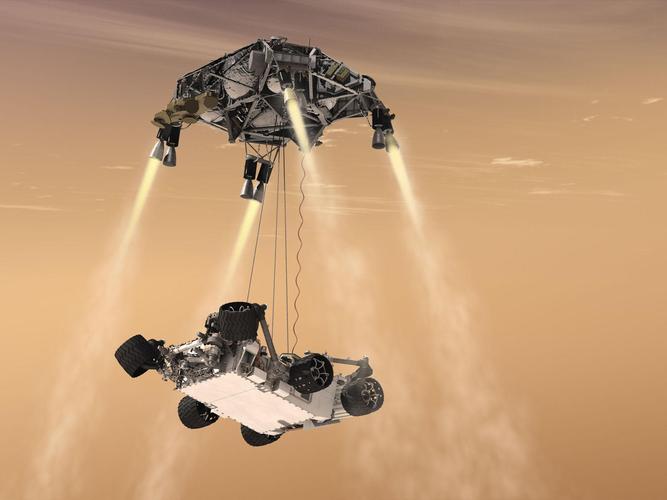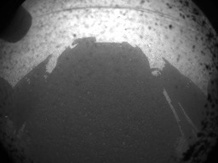
The best place to stand in the entire solar system at 1:14 a.m. ET Monday was about 150 million miles away, at the bottom of Gale Crater near the equator of the Red Planet.
Looking west around mid-afternoon local time, a Martian bystander would have seen a rocket-powered alien spacecraft approach and then hover about 60 feet over the rock-strewn plain between the crater walls and the towering slopes of nearby Mount Sharp.
A gangly vehicle, about the size of a small car on Earth, descended from the spacecraft on nylon cords amid blowing crimson dust. As soon as this machine touched the soil with its six wheels, its delivery craft abruptly disconnected the cables and, with the last of its fuel, safely careened away from its passenger. NASA’s new Mars rover, Curiosity, had landed.
Fourteen minutes later, news of these strange happenings reached the people on Earth who were responsible:
“Touchdown confirmed!”
With those words, the mission control team at the space agency’s Jet Propulsion Laboratory in Pasadena, Calif., erupted in cheers, applause and hugs. And as the first pictures began to arrive from their nuclear-powered explorer, the celebrations grew louder and continued well into a televised news conference an hour later.

“Needless to say there’s a lot of excitement in this room,” said the laboratory’s director, Charles Elachi.
When it comes to visitors like the $2.5-billion Curiosity rover, Mars has been a reclusive, get-off-of-my-lawn host. Of 13 previous attempts to land space probes on the Red Planet over the past four decades, nearly half failed or immediately lost contact.
Those odds were enough to make for a tense scene at mission control in the days and hours leading up the landing. “You can’t believe the tension and uncertainty here at JPL,” NPR science correspondent Joe Palca reported from the laboratory. “The anxiety just couldn’t be denied.”
The novel use of the rocket-powered “sky crane” to lower the one-ton robot to the Martian surface only added to the drama.
“I was on the edge of my seat,” former astronaut and NASA Administrator Charlie Bolden Jr. told NASA TV moments after the landing.
With the suspenseful landing behind them, mission controllers quickly turned their attention to Curiosity’s coming months of work on the Martian surface. The rover is expected to spend two years exploring Gale Crater and the three-mile-high mountain within it.
“Tomorrow,” JPL’s Elachi said, “we’re going to start exploring Mars.”
NASA TV has been streaming video of the overnight events at the Jet Propulsion Laboratory and plans to carry the next scheduled news conference at Noon ET.
For more details on this historic event, check out NPR’s ongoing coverage here.
